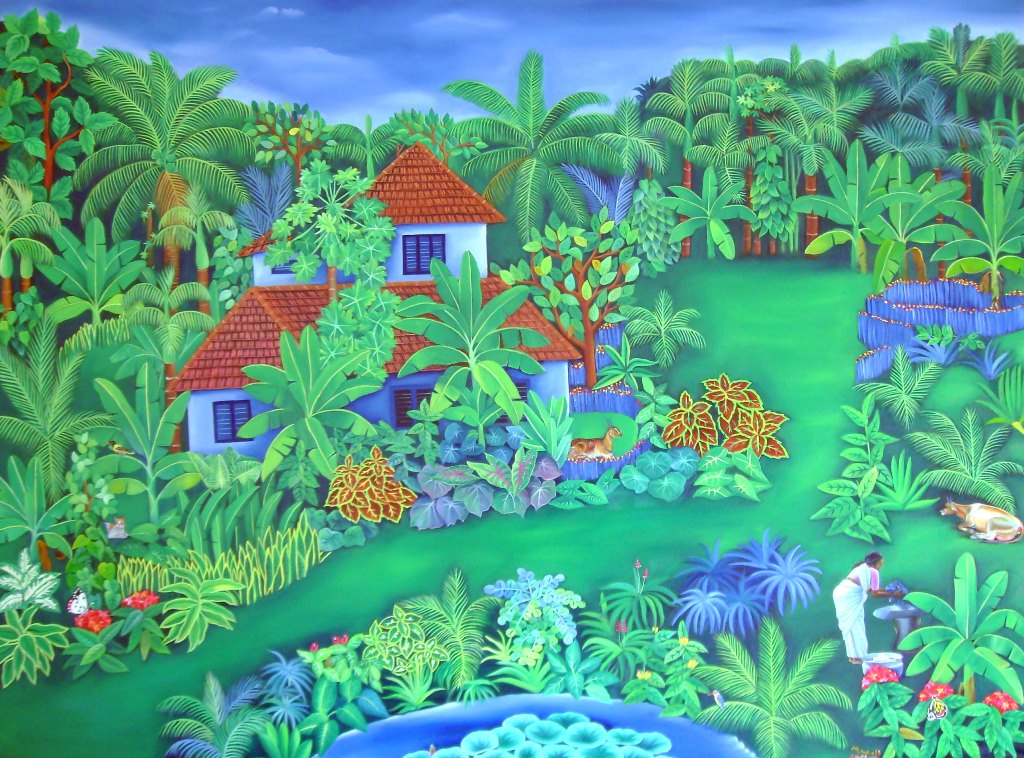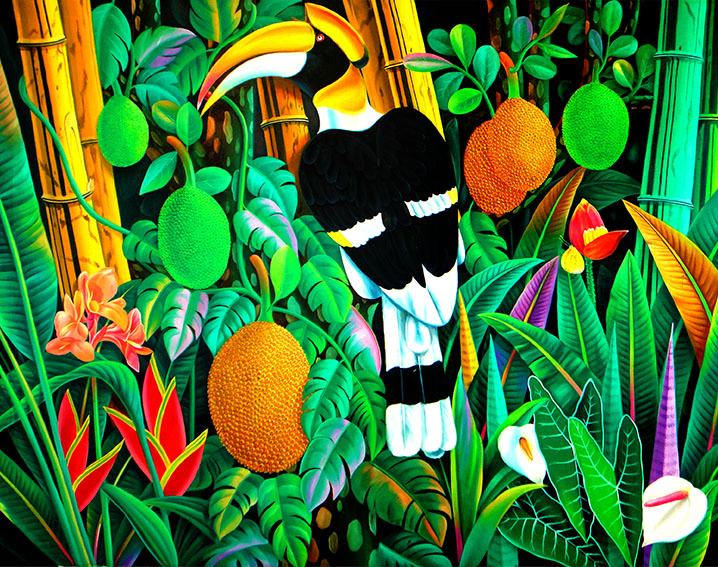Compelled by the raw poetry of Murali’s dazzling heliconias, clusters of surreal pink coconuts, glistening lotuses thrusting out of primeval waters, and the luminous plumage of birds, the eye is ravished, and as a result, often overlooks the sub-titles and ironies that lie just below the surface lushness. The whimsical portraits of real children – his own, and the sons and daughters of neighbours and friends – look out at us from a sheltering landscape, their figures partially obscured or overhung by foliage. Large leaves, or shrubbery most often embrace the human figure, and even human habitations – the comfortable cottage, or the traditional, two storied, slant roofed Kerala houses -emerge from overhanging greenery. The wilderness appears as an extension of the human form, not distinct from it.
Murali’s people are organic, one with the burgeoning, extravagantly beautiful, external landscape, but they appear to be immersed in inner worlds of their own, to which we have limited access. Children engaged in a game of hide and seek occupy their own, secret worlds, each one separate from their companions, sometimes leaving them behind altogether, to soar skywards in a rhapsody of flight. A young boy peers out from behind trailing creepers, a chameleon like quality in the way he blends with the background. A woman scaling fish, another washing clothes, are engaged in mundane chores, but their gaze that is directed inwards. Vaikom Basheer, the noted Malayalam writer, once deeply involved in the revolutionary politics of pre- independence India, lounges in a chair in a bucolic landscape, playfully dotted with characters from his stories.
Animals and birds, on the other hand – the goats, cats, and cows that lounge on verandahs, and in gardens and backyards – present themselves boldly, sometimes staring directly at the viewer. Birds perch prominently on trees, not bothering to camouflage themselves. Murali’s flora and fauna fill the canvas with a complete disregard for scale or proportion, and with seeming abandon. But on closer observation, his wilderness is in fact carefully structured, cottages parceled off from their surroundings by neat and emphatic borders of sansevieria, and his jungle contained by his artistic imagination. Occasionally, the green overwhelms the foreground, hinting at the fact that while his works are grounded in the fecundity of Kerala’s landscape, they are also a fantasy, an idyll. A persistent thread of magic realism runs through his work, so that his representations are dreamscapes, as much as they are landscapes, drawing him much closer to the Latin American naïve artists, rather than Henri Rousseau, with whom he has been frequently compared. There is a thematic and stylistic concurrence between the works of Vilma Duarte, Leoncio Saenz, Alejandro Guevara, and the extraordinary mural entitled Paisaje Primitivista (Primitive Landscape) in Managua, which was later destroyed, and Murali Nagapuzha’s ‘My Native Village’, ‘Childhood Dreams’ ‘Greenland’ and earlier works on tribal women, and fisher-folk, which cannot be ignored. A gift of artwork from a friend who travelled to Nicaragua, on a Government invitation gave impetus to Murali’s experiments in developing his own, distinctive expression of his responses to the world around him. Revolution across Latin America and resistance against totalitarian regimes produced some of the most distinctive art of the 20th century, drawing on themes of ordinary people going about their tasks, the cadences of rural life in harmony with nature. For Murali, it was a far more personal and traumatic journey. The politics of a mid-1970’s India were to have a serious impact on his artistic vision when, during the state of Emergency, he faced the shock of a suspended democracy, and confronted a repressive state that crushed civil liberties. His strongly Leftist political convictions and activities as a student led to raids, threats, harassment and questioning of his family, to colleagues being arrested, and ultimately, the tragic death of a close friend, after being held in police custody. The silence that pervaded intellectual circles was deafening. Faced with political murders and state violence, Murali, his vision directed inwards, set about recreating the world, in works tinged with nostalgia, where violence and injustice were overwritten with beauty, innocence and wonder. In the spreading leaves of the bread-fruit tree, the monsteras, cultivars and magenta veins of caladium, in the depth of the exaggerated colours, what we experience is an act of creation, a lushness and intensity of a scarcely peopled planet, a metaphor for a world of possibilities, what the artist, in an earlier interview, has called ” the innocence typical of a bygone village in Kerala.”
A persistent thread of magic realism runs through his work, so that his representations are dreamscapes, as much as they are landscapes, drawing him much closer to the Latin American naïve artists, rather than Henri Rousseau, with whom he has been frequently compared. There is a thematic and stylistic concurrence between the works of Vilma Duarte, Leoncio Saenz, Alejandro Guevara, and the extraordinary mural entitled Paisaje Primitivista (Primitive Landscape) in Managua, which was later destroyed, and Murali Nagapuzha’s ‘My Native Village’, ‘Childhood Dreams’ ‘Greenland’ and earlier works on tribal women, and fisher-folk, which cannot be ignored. A gift of artwork from a friend who travelled to Nicaragua, on a Government invitation gave impetus to Murali’s experiments in developing his own, distinctive expression of his responses to the world around him. Revolution across Latin America and resistance against totalitarian regimes produced some of the most distinctive art of the 20th century, drawing on themes of ordinary people going about their tasks, the cadences of rural life in harmony with nature. For Murali, it was a far more personal and traumatic journey. The politics of a mid-1970’s India were to have a serious impact on his artistic vision when, during the state of Emergency, he faced the shock of a suspended democracy, and confronted a repressive state that crushed civil liberties. His strongly Leftist political convictions and activities as a student led to raids, threats, harassment and questioning of his family, to colleagues being arrested, and ultimately, the tragic death of a close friend, after being held in police custody. The silence that pervaded intellectual circles was deafening. Faced with political murders and state violence, Murali, his vision directed inwards, set about recreating the world, in works tinged with nostalgia, where violence and injustice were overwritten with beauty, innocence and wonder. In the spreading leaves of the bread-fruit tree, the monsteras, cultivars and magenta veins of caladium, in the depth of the exaggerated colours, what we experience is an act of creation, a lushness and intensity of a scarcely peopled planet, a metaphor for a world of possibilities, what the artist, in an earlier interview, has called ” the innocence typical of a bygone village in Kerala.” 
“We would have found our lives insufferable,” wrote the artist K.G. Subramanyan ” if we did not have this power of fantasy inducing various delusions, day dreams, nostalgias and utopias. If we did not see on our faces that engaging mask that we see every day, or transform the faces of the people we cherish with the magic of sentiment, or dress up our drab environment with the shimmering lamps of recollections, we would be overcome in no time at all by a feeling of diffidence and self-deprecation, regardless of whether we are realists, radicals, pragmatists, or men of sound common sense.” It is this sense of wonder, and transformation that Murali brings to his works.
In the ‘Childhood’ series, winged heavenly beings lean down from the skies with trays of offerings for wonder-struck children below and, in a slightly later work, the children themselves sprout wings and soar through the air. Like the Latin American naïve artists, Murali incorporates the mythologies of the land – a child in the background is in fact the Boy-God Krishna, emerging from the shrubbery, his face smiling, inscrutable, innocent and yet knowing. In ‘Jungle’, Murali lifts the masked spirit medium ‘tiger-man’, who cavorts, painted with tiger stripes or leopard spots in villages and towns, out of his familiar setting, and places him in the heart of a real forest, prompting the possibility of an ironic encounter with a real tiger.

It is significant that Murali has struck a deep, universal chord, in the responses he evokes, anchored as his works are in Kerala, with successful shows in Moscow, London and Paris, a grant from the Pollock-Krasner Foundation, and the offer of a French Government Residency Programme.
Murali Nagapuzha has travelled great distances. From the Zoology student diligently sketching flora and fauna, to poster painter and collage maker for political causes, through his early experiments in art in the wake of the Cholamandalam group, to finding his own, distinctive medium. His work is naïve in the truest sense of the word, of being self-taught, uncluttered by convention or dogma of any sort. In The Creative Circuit, K.G. Subramanyan wrote of the artistic process: ” In their growth years, they collect enough imaginative resources…(which)… provides a well- designed passage between their inner and outer world. For it is the mediator, their vision is its vision, their voice is its voice.” Murali has found his voice, one of the most unselfconscious and vibrant in contemporary Indian Art.
Image Courtesy: Murali Nagapuzha





Thanks . Simply wonderful to read about the Artist Murali Nagapusha and see samples of his mind boggling art work.
God Bless you and the Artist